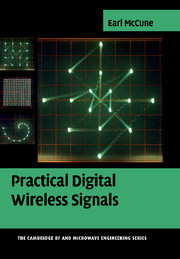Book contents
- Frontmatter
- Contents
- Preface
- Definitions and acronyms
- Terminology and notation
- 1 Keying, states, and block diagram construction
- 2 Common issues and signal characterization
- 3 Important details on results from Shannon, Nyquist, and others
- 4 Digital amplitude modulation (ASK)
- 5 Digital frequency modulation: FSK
- 6 Digital phase modulation: PSK
- 7 Combined digital modulations: QAM and OFDM
- 8 Spread spectrum
- 9 Wireless propagation and antenna fundamentals
- 10 Principles of coding
- 11 Multiple access techniques
- 12 Signal tradeoffs and system evolution
- Tutorial Appendices
- Index
- References
2 - Common issues and signal characterization
Published online by Cambridge University Press: 04 August 2010
- Frontmatter
- Contents
- Preface
- Definitions and acronyms
- Terminology and notation
- 1 Keying, states, and block diagram construction
- 2 Common issues and signal characterization
- 3 Important details on results from Shannon, Nyquist, and others
- 4 Digital amplitude modulation (ASK)
- 5 Digital frequency modulation: FSK
- 6 Digital phase modulation: PSK
- 7 Combined digital modulations: QAM and OFDM
- 8 Spread spectrum
- 9 Wireless propagation and antenna fundamentals
- 10 Principles of coding
- 11 Multiple access techniques
- 12 Signal tradeoffs and system evolution
- Tutorial Appendices
- Index
- References
Summary
Independent of the type of digital wireless communication signal which is selected for a particular application, there are many common characteristics that it will share with all other digital wireless communication signals. This chapter introduces these common characteristics and presents their basic principles.
Also included are discussions regarding performance and characterization measurements that are commonly used for digital wireless communications. These focus on characteristics that are commonly seen in DWC signal specifications. In addition, commonly used tools called Informational Diagrams are also introduced.
Power spectral density (PSD)
Often just referred to as “the spectrum” with some abuse of terminology, the power spectral density of a DWC signal is a representation of the amount of signal power present within a particular measurement bandwidth. The key here is that last phrase: in a particular measurement bandwidth. This is critical to the unambiguous use of this term.
The PSD is an individual property of each specific signal, so the actual PSD is strongly dependent on the specific modulating waveform applied. In order to have PSD measurements that are more dependent on the modulation type so they can be used to compare one type of DWC signal with another, it is necessary to add two conditions, one to the modulation and one to the measurement. These additional conditions are
the modulating waveform must randomly access all possible signal states uniformly, preferably also across all possible transitions, and
the measurement must take long-term averages at each frequency where the signal contains energy.
- Type
- Chapter
- Information
- Practical Digital Wireless Signals , pp. 23 - 73Publisher: Cambridge University PressPrint publication year: 2010
References
- 1
- Cited by



